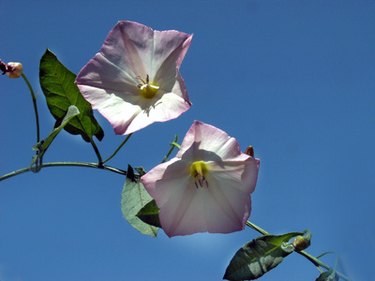Things You'll Need
1 pound of sodium chlorate
1 gallon of water
Rubber gloves
Spray bottle
Bucket
Stirring stick

Bindweed, a relative of the morning glory vine, was brought to America from eastern Europe over 200 years ago, according to Associated Content. Though bindweed is considered by many American gardeners and farmers one of the most hated weeds in America, Eastern Europeans do not consider bindweed a weed. There are insects native to Eastern Europe, aptly named the bindweed mite and the bindweed moth, that help keep bindweed from getting out of hand. As recently as 2007, the bindweed mite has been imported to America in an attempt to control the growth of bindweed.
Preparing the Solution
Step 1
Put one pound of sodium chlorate into a one gallon bucket of water.
Video of the Day
Step 2
Stir until the sodium chlorate is fully dissolved.
Step 3
Siphon your solution into a spray bottle.
Step 4
Be careful not to get your solution on your lawn or other plants. Sodium chlorate, according to Kansas State Agricultural College, is highly toxic to all plants, not just to bindweed, and will kill any plant on which it lands.
Applying the Solution
Step 1
Completely drench the leaves of the bindweed. Kansas State Agricultural College suggests that you do your first application before the bindweed flowers, in late May or early June.
Step 2
Repeat your application of the sodium chloride solution four to six weeks after your first application. Again, completely saturate the leaves of the bindweed plant.
Step 3
Apply the solution for the third time four to six weeks after the second application. Kansas State Agricultural College finds that three applications of sodium chlorate has the greatest success rate in eliminating bindweed infestations.
Tip
Because bindweed roots can grow as deep as thirty inches, according to Down Garden Services, they are difficult to reach with topical herbicides. The application of sodium chlorate kills the roots by interfering with the ability of bindweed leaves to produce food. Not being able to make new food, the plant relies on the nutrients stored in its roots. Eventually, the plant uses up its stored resources and dies.
You can purchase sodium chlorate at most garden centers.
Video of the Day